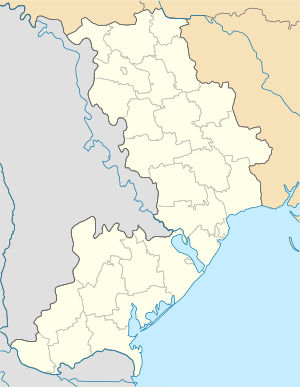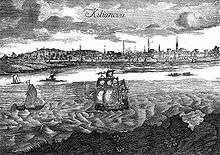Kiliya
| Kiliya Кілія | ||
|---|---|---|
|
Skyline of Kiliya from one of the churches | ||
| ||
 Kiliya Location in Ukraine  Kiliya Kiliya (Ukraine) | ||
| Coordinates: 45°27′N 29°14′E / 45.450°N 29.233°E | ||
| Country |
| |
| Oblast | Odessa Oblast | |
| Raion | Kiliya Raion | |
| City founded | 862 | |
| Government | ||
| • Mayor | Valentin Ivanovich Bobrovskyi | |
| Area | ||
| • Total | 19.5 km2 (7.5 sq mi) | |
| Elevation | 5 m (16 ft) | |
| Population (2015) | ||
| • Total | 20,311 | |
| • Density | 1,000/km2 (2,700/sq mi) | |
| Time zone | UTC+2 (EET) | |
| • Summer (DST) | UTC+3 (EEST) | |
| Postal code | 68300 - 68303 | |
| Area code(s) | +380 4843 | |
Kiliya (Ukrainian: Кілія; Russian: Килия; Romanian: Chilia [-Nouă]; Moldovan (Cyrillic): Килия [-Ноуэ]; Polish: Kilia; Greek: Κελλία, Kellía; Turkish: Kilya) is a small city in Odessa Oblast (province) of southwestern Ukraine. It is the administrative center of Kiliya Raion (district), and is located in the Danube Delta, in the Bessarabian historic district of Budjak. The Chilia branch of the Danube river, which separates Ukraine from Romania, is named after Kiliya. Population: 20,311 (2015 est.)[1]
History
![]()
![]()
![]()
![]()
![]()
![]()
![]()
![]()
![]()
![]()
![]()
![]()
A town on the Romanian side of the Chilia branch of the Danube, known as Chilia Veche (Ukrainian: Cтapa Кілія, translit. Stara Kiliya) or "Older Chilia", was founded by the Byzantines - κελλία, kellia being the equivalent of "granaries", a name first recorded in 1241, in the works of the Persian chronicler Rashid-al-Din Hamadani.
Kiliya is therefore sometimes referred to as Nova Kiliya (Russian: Hoво Килия, Ukrainian: Hoва Кілія, translit. Novo Kiliya, Romanian: Chilia Nouă), or "New Kiliya". It was founded by Stephen the Great of Moldavia, in order to counteract the Ottoman Empire which had taken control over Chilia Veche in the 15th century. It was a major Moldavian port. However, it was eventually conquered by the Ottomans in 1484, who kept it until 1790, when it was taken by Russian army under the command of the general Ivan Gudovich during Russo-Turkish War (1787–1792). The Times of London reported that "35,000 of the inhabitants were involved in a general massacre," an incident that had "been celebrated in prose and poetry." [2] The city was given back to the Ottomans in 1792, but retaken by the Russians in 1806 and awarded to them officially in 1812.

After being bombarded by the Anglo-French fleet in July 1854 during the Crimean War, it was given to Romania in the Treaty of Paris (1856). In 1878, Kiliya was transferred back to Russia together with Budjak. Between 1918 and 1940 it was again part of Romania, then integrated in the Soviet Union and the Ukrainian SSR (it was briefly held yet again by Romania, from 1941 to 1944, during World War II), and passed on to independent Ukraine after the Soviet downfall.
The oldest building in Kiliya is the semi-subterranean church of St. Nicholas, which may go back to 1485, although an old inscription in the church claims that it was founded on 10 May 1647.
Gallery
References
- ↑ "Чисельність наявного населення України (Actual population of Ukraine)" (PDF) (in Ukrainian). State Statistics Service of Ukraine. Retrieved 1 July 2016.
- ↑ "The Seat of War on the Danube," The Times, December 29, page 8


.jpg)
.jpg)
